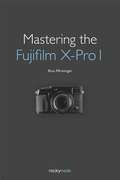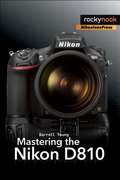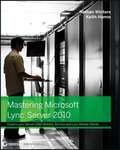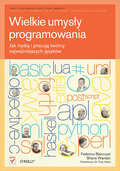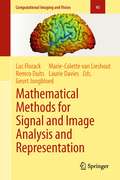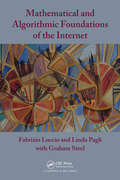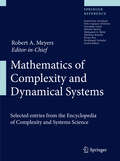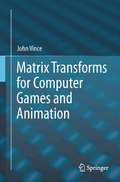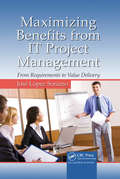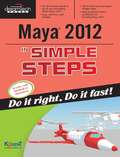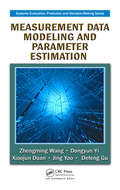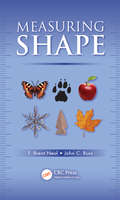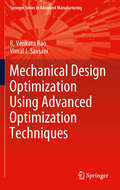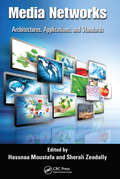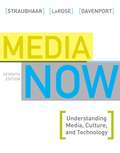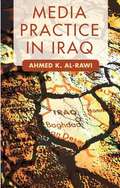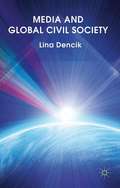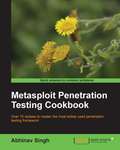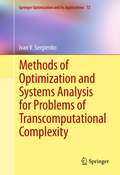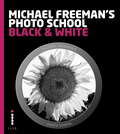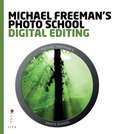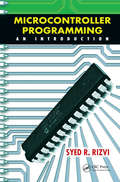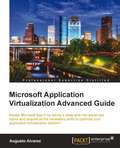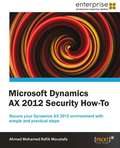- Table View
- List View
Mastering the Fujifilm X-Pro 1
by Rico PfirstingerMastering the Fujifilm X-Pro 1 provides a wealth of experienced-based information and insights for owners of the new X-Pro 1 camera. Readers will learn about the features and capabilities of the X-Pro 1 and will discover numerous tips and tricks for how to maximize its potential. With the X-Pro 1, Fujifilm released the first mirrorless camera with an APS-C sensor. The successful combination of high-end retro design and state-of-the-art digital camera technology, originally seen in the X100 viewfinder camera, has been pushed even further to achieve this interchangeable-lens camera. The X-Pro 1 offers three FUJINON interchangeable lenses. In a layout suitable to the camera's attractive design, this manual presents imagery that attests to the fun you will have as you begin to push the envelope of your Fujifilm X-Pro 1.
Mastering the Nikon D800
by Darrell YoungMastering the Nikon D800 by Darrell Young provides a wealth of experience-based information and insights for owners of the new D800 camera. Darrell is determined to help the user navigate past the confusion that often comes with complex and powerful professional camera equipment. This book explores the features and capabilities of the camera in a way that far surpasses the user's manual. It guides readers through the camera features with step-by-step setting adjustments; color illustrations; and detailed how, when, and why explanations for each option. Every button, dial, switch, and menu configuration setting is explored in a user-friendly manner, with suggestions for setup according to various shooting styles. Darrell's friendly and informative writing style allows readers to easily follow directions, while feeling as if a friend dropped in to share his knowledge. The learning experience for new D800 users goes beyond just the camera itself and covers basic photography technique.
Mastering: LyncTM Server 2010
by Nathan Winters Keith HannaAn in-depth guide on the leading Unified Communications platform Microsoft Lync Server 2010 maximizes communication capabilities in the workplace like no other Unified Communications (UC) solution. Written by experts who know Lync Server inside and out, this comprehensive guide shows you step by step how to administer the newest and most robust version of Lync Server. Along with clear and detailed instructions, learning is aided by exercise problems and real-world examples of established Lync Server environments. You'll gain the skills you need to effectively deploy Lync Server 2010 and be on your way to gaining all the benefits UC has to offer. Gets you up and running with Lync Server--whether you are migrating from Office Communications Server or new to Lync Server. Walks you through all of the essential stages for deploying Lync Server Shows integration with Microsoft Exchange Server and Microsoft SharePoint Server Demonstrates how to monitor, diagnose, and troubleshoot problems more efficiently Mastering Lync Server 2010 is a must-have resource for anyone looking to manage all the various forms of communication from one user interface.
Masterminds of Programming. Conversations with the Creators of Major Programming Languages
by Federico Biancuzzi i Chromatic<p>Droga od pomys?u do gotowej aplikacji jest d?uga i kr?ta. Najprawdopodobniej jednym z najd?u?szych jej odcinków jest ten po?wi?cony na programowanie. Sztab ludzi, wiele j?zyków ...</p>
Mathematical Methods for Signal and Image Analysis and Representation
by Luc Florack Marie-Colette van Lieshout Remco Duits Geurt Jongbloed Laurie DaviesMathematical Methods for Signal and Image Analysis and Representation presents the mathematical methodology for generic image analysis tasks. In the context of this book an image may be any m-dimensional empirical signal living on an n-dimensional smooth manifold (typically, but not necessarily, a subset of spacetime). The existing literature on image methodology is rather scattered and often limited to either a deterministic or a statistical point of view. In contrast, this book brings together these seemingly different points of view in order to stress their conceptual relations and formal analogies. Furthermore, it does not focus on specific applications, although some are detailed for the sake of illustration, but on the methodological frameworks on which such applications are built, making it an ideal companion for those seeking a rigorous methodological basis for specific algorithms as well as for those interested in the fundamental methodology per se. Covering many topics at the forefront of current research, including anisotropic diffusion filtering of tensor fields, this book will be of particular interest to graduate and postgraduate students and researchers in the fields of computer vision, medical imaging and visual perception.
Mathematical Methods for Signal and Image Analysis and Representation (Computational Imaging and Vision #41)
by Luc Florack Marie-Colette van Lieshout Remco Duits Geurt Jongbloed Laurie DaviesMathematical Methods for Signal and Image Analysis and Representation presents the mathematical methodology for generic image analysis tasks. In the context of this book an image may be any m-dimensional empirical signal living on an n-dimensional smooth manifold (typically, but not necessarily, a subset of spacetime). The existing literature on image methodology is rather scattered and often limited to either a deterministic or a statistical point of view. In contrast, this book brings together these seemingly different points of view in order to stress their conceptual relations and formal analogies.Furthermore, it does not focus on specific applications, although some are detailed for the sake of illustration, but on the methodological frameworks on which such applications are built, making it an ideal companion for those seeking a rigorous methodological basis for specific algorithms as well as for those interested in the fundamental methodology per se.Covering many topics at the forefront of current research, including anisotropic diffusion filtering of tensor fields, this book will be of particular interest to graduate and postgraduate students and researchers in the fields of computer vision, medical imaging and visual perception.
Mathematical and Algorithmic Foundations of the Internet (Chapman & Hall/CRC Applied Algorithms and Data Structures series)
by Fabrizio Luccio Linda Pagli Graham SteelTo truly understand how the Internet and Web are organized and function requires knowledge of mathematics and computation theory. Mathematical and Algorithmic Foundations of the Internet introduces the concepts and methods upon which computer networks rely and explores their applications to the Internet and Web. The book offers a unique approach to
Mathematics of Complexity and Dynamical Systems
by Robert A. MeyersMathematics of Complexity and Dynamical Systems is an authoritative reference to the basic tools and concepts of complexity, systems theory, and dynamical systems from the perspective of pure and applied mathematics. Complex systems are systems that comprise many interacting parts with the ability to generate a new quality of collective behavior through self-organization, e.g. the spontaneous formation of temporal, spatial or functional structures. These systems are often characterized by extreme sensitivity to initial conditions as well as emergent behavior that are not readily predictable or even completely deterministic. The more than 100 entries in this wide-ranging, single source work provide a comprehensive explication of the theory and applications of mathematical complexity, covering ergodic theory, fractals and multifractals, dynamical systems, perturbation theory, solitons, systems and control theory, and related topics. Mathematics of Complexity and Dynamical Systems is an essential reference for all those interested in mathematical complexity, from undergraduate and graduate students up through professional researchers.
Matrix Transforms for Computer Games and Animation
by John VinceMatrix transforms are ubiquitous within the world of computer graphics, where they have become an invaluable tool in a programmer's toolkit for solving everything from 2D image scaling to 3D rotation about an arbitrary axis. Virtually every software system and hardware graphics processor uses matrices to undertake operations such as scaling, translation, reflection and rotation. Nevertheless, for some newcomers to the world of computer games and animation, matrix notation can appear obscure and challenging. Matrices and determinants were originally used to solve groups of simultaneous linear equations, and were subsequently embraced by the computer graphics community to describe the geometric operations for manipulating two- and three-dimensional structures. Consequently, to place matrix notation within an historical context, the author provides readers with some useful background to their development, alongside determinants. Although it is assumed that the reader is familiar with everyday algebra and the solution of simultaneous linear equations, Matrix Transforms for Computer Games and Animation does not expect any prior knowledge of matrix notation. It includes chapters on matrix notation, determinants, matrices, 2D transforms, 3D transforms and quaternions, and includes many worked examples to illustrate their practical use.
Maximizing Benefits from IT Project Management: From Requirements to Value Delivery
by Jose Lopez SorianoWith the majority of IT projects being delivered late, over budget, or cancelled altogether, it is clear that traditional project management methodologies do not provide an effective framework for today's IT projects. It is evident that a new Return-on-Investment (ROI) oriented approach is required that focuses on the ROI of a project fro
Maya 2012 in Simple Steps
by Kogent Learning Solution IncThis book helps you to create, send, and receive e-mail messages and keep track of appointments and To-Do List. With the help of this book, you will learn to schedule your meetings, appointments, and events. In addition, this book teaches you to manage your tasks and events as well as apply rules on an e-mail message. Through this book, you can also learn to secure your e-mail messages and apply digital signatures on them. The key features of this book include a detailed coverage of MS Outlook 2010 along with its new features in an easy-to-understand language with lots of illustrations. The content of the book is arranged in such a way that it would be beneficial for both the beginners as well as for professionals who want to upgrade their learning skills. The book covers: Launching the MS Outlook 2010 application and exploring its user interface Introducing new features, which include the Backstage view, Ribbon, the Conversation view, Quick Steps, Mail Tips, Suggested Contacts, Outlook Social Connector, Cleanup tools, the Ignore option, Paste Preview, Insert Screenshots, the Schedule view, and Publish Calendar Online Composing, sending, receiving, replying, and forwarding an e-mail message Managing Contacts and working with Outlook Social Connector Scheduling your appointments, meetings, and events Working with Tasks, Notes, and Rules Securing an e-mail message by encrypting it and creating a digital signature
Measurement Data Modeling and Parameter Estimation (Systems Evaluation, Prediction, and Decision-Making)
by Xiaojun Duan Zhengming Wang Dongyun Yi Jing Yao Defeng GuThis book discusses the theories, methods, and application techniques of the measurement data mathematical modeling and parameter estimation. It seeks to build a bridge between mathematical theory and engineering practice in the measurement data processing field so theoretical researchers and technical engineers can communicate. It is organized with abundant materials, such as illustrations, tables, examples, and exercises. The authors create examples to apply mathematical theory innovatively to measurement and control engineering. Not only does this reference provide theoretical knowledge, it provides information on first hand experiences.
Measuring Shape
by John C. Russ F. Brent Neal"John Russ is the master of explaining how image processing gets applied to real-world situations. With Brent Neal, he’s done it again in Measuring Shape, this time explaining an expanded toolbox of techniques that includes useful, state-of-the-art methods that can be applied to the broad problem of understanding, characterizing, and measuring shape. He has a gift for finding the kernel of a particular algorithm, explaining it in simple terms, then giving concrete examples that are easily understood. His perspective comes from solving real-world problems and separating out what works in practice from what is just an abstract curiosity." —Tom Malzbender, Hewlett-Packard Laboratories, Palo Alto, California, USA Useful for those working in fields including industrial quality control, research, and security applications, Measuring Shape is a handbook for the practical application of shape measurement. Covering a wide range of shape measurements likely to be encountered in the literature and in software packages, this book presents an intentionally diverse set of examples that illustrate and enable readers to compare methods used for measurement and quantitative description of 2D and 3D shapes. It stands apart through its focus on examples and applications, which help readers quickly grasp the usefulness of presented techniques without having to approach them through the underlying mathematics. An elusive concept, shape is a principal governing factor in determining the behavior of objects and structures. Essential to recognizing and classifying objects, it is the central link in manmade and natural processes. Shape dictates everything from the stiffness of a construction beam, to the ability of a leaf to catch water, to the marketing and packaging of consumer products. This book emphasizes techniques that are quantitative and produce a meaningful yet compact set of numerical values that can be used for statistical analysis, comparison, correlation, classification, and identification. Written by two renowned authors from both industry and academia, this resource explains why users should select a particular method, rather than simply discussing how to use it. Showcasing each process in a clear, accessible, and well-organized way, they explore why a particular one might be appropriate in a given situation, yet a poor choice in another. Providing extensive examples, plus full mathematical descriptions of the various measurements involved, they detail the advantages and limitations of each method and explain the ways they can be implemented to discover important correlations between shape and object history or behavior. This uncommon assembly of information also includes sets of data on real-world objects that are used to compare the performance and utility of the various presented approaches.
Mechanical Design Optimization Using Advanced Optimization Techniques
by R. Venkata Rao Vimal J. SavsaniMechanical design includes an optimization process in which designers always consider objectives such as strength, deflection, weight, wear, corrosion, etc. depending on the requirements. However, design optimization for a complete mechanical assembly leads to a complicated objective function with a large number of design variables. It is a good practice to apply optimization techniques for individual components or intermediate assemblies than a complete assembly. Analytical or numerical methods for calculating the extreme values of a function may perform well in many practical cases, but may fail in more complex design situations. In real design problems, the number of design parameters can be very large and their influence on the value to be optimized (the goal function) can be very complicated, having nonlinear character. In these complex cases, advanced optimization algorithms offer solutions to the problems, because they find a solution near to the global optimum within reasonable time and computational costs. Mechanical Design Optimization Using Advanced Optimization Techniques presents a comprehensive review on latest research and development trends for design optimization of mechanical elements and devices. Using examples of various mechanical elements and devices, the possibilities for design optimization with advanced optimization techniques are demonstrated. Basic and advanced concepts of traditional and advanced optimization techniques are presented, along with real case studies, results of applications of the proposed techniques, and the best optimization strategies to achieve best performance are highlighted. Furthermore, a novel advanced optimization method named teaching-learning-based optimization (TLBO) is presented in this book and this method shows better performance with less computational effort for the large scale problems. Mechanical Design Optimization Using Advanced Optimization Techniques is intended for designers, practitioners, managers, institutes involved in design related projects, applied research workers, academics, and graduate students in mechanical and industrial engineering and will be useful to the industrial product designers for realizing a product as it presents new models and optimization techniques to make tasks easier, logical, efficient and effective. .
Media Networks: Architectures, Applications, and Standards
by Sherali Zeadally Hassnaa MoustafaA rapidly growing number of services and applications along with a dramatic shift in users' consumption models have made media networks an area of increasing importance. Do you know all that you need to know?Supplying you with a clear understanding of the technical and deployment challenges, Media Networks: Architectures, Applications, and Standard
Media Now: Understanding Media, Culture, and Technology
by Joseph Straubhaar Robert Larose Lucinda DavenportMEDIA NOW, Seventh Edition, empowers you to think critically about the media and its effects on culture by providing a thorough understanding of how media technologies develop, operate, converge, and affect society. MEDIA NOW prepares you for encounters in the expanding fields of the Internet, interactive media, and traditional media industries through engaging, up-to-date material that covers the essential history, theories, concepts, and technical knowledge you need to thrive. Extensively updated in a new sixth edition, MEDIA NOW provides a comprehensive introduction to today's global media environment and ongoing developments in technology, culture, and critical theory that continue to transform this rapidly evolving industry and affect our daily lives.
Media Practice in Iraq
by Ahmed K. Al-RawiA historical survey of the Iraqi media from its beginning up to the present day, focusing on the post-2003 media scene and the political and societal divisions that occurred in Iraq after US-led occupation. Investigates the nature of the media outlets and offers an analysis of the way Iraqi satellite channels covered the 2010 general elections.
Media and Global Civil Society
by Lina DencikA timely and critical investigation into the way media operates in a so-called global age, presenting new empirical data on key sites of news production and crucially tying these findings to ongoing debates on globalization and democracy.
Metasploit Penetration Testing Cookbook
by Abhinav SinghThis is a Cookbook which follows a practical task-based style. There are plenty of code and commands used for illustration which make your learning curve easy and quick.This book targets both professional penetration testers as well as new users of Metasploit who wish to gain expertise over the framework. The book requires basic knowledge of scanning, exploitation, and Ruby language.
Methods of Optimization and Systems Analysis for Problems of Transcomputational Complexity
by Ivan V. SergienkoThis work presents lines of investigation and scientific achievements of the Ukrainian school of optimization theory and adjacent disciplines. These include the development of approaches to mathematical theories, methodologies, methods, and application systems for the solution of applied problems in economy, finances, energy saving, agriculture, biology, genetics, environmental protection, hardware and software engineering, information protection, decision making, pattern recognition, self-adapting control of complicated objects, personnel training, etc. The methods developed include sequential analysis of variants, nondifferential optimization, stochastic optimization, discrete optimization, mathematical modeling, econometric modeling, solution of extremum problems on graphs, construction of discrete images and combinatorial recognition, etc. Some of these methods became well known in the world's mathematical community and are now known as classic methods.
Michael Freeman's Photo School: Black And White (Michael Freeman's Photo School)
by Michael FreemanFrom timeless, elegant portraits to gritty, graphic street shots, the possibilities of black and white are endless, enticing, and exciting. Recognising this potential within every shot, and knowing the digital-editing tools and techniques to maximize its effect are essential steps to building up your photographic repertoire.Having first established the fundamental aesthetic choices that go into every B&W conversion, Michael Freeman goes on to review the noble tradition of black and white, detailing its numerous styles and fashions, with step-by-step instructions on how to achieve each effect, regardless of your particular software. Presented in a straightforward and easy-to-understand format, you will soon be able to both visualise exactly how you want your final image to appear, and achieve that signature look with efficient workflows and powerful conversion techniques.These skills open up new worlds of photographic opportunity everywhere you look, and encourage artistic growth just as much as they inspire you to try new styles and exciting treatments.
Michael Freeman's Photo School: Digital Editing: Essential Aspects Of Digital Editing (Michael Freeman's Photo School)
by Michael FreemanUnlock the full potential of each and every image with reliable post-production techniques that will become a fundamental part of your photography. Using easily followed, step-by-step instructions, Michael Freeman demystifies the complexities of today's high-powered editing programs to provide you with effective digital workflows tailored to your particular photographic style, and using whichever editing programs you are most comfortable with.Begin by exploring the fundamental aspects of image optimisation, from fixing exposure and making colour adjustments, to sharpening and noise reduction - essential steps that elevate simple snapshots to stunning images. Then move on to explore the advanced possibilities of black-and-white conversion, panoramic stitching, HDR imaging, and more. Learn to recognise the right tools for the job, saving you time on the computer and ensuring each image gets the treatment it deserves.Whether you're salvaging an underexposed shot or building a composite of multiple images, these techniques will give your photography a professional and refined style.
Microcontroller Programming: An Introduction
by Syed R. RizviMicrocontroller Programming: An Introduction is a comprehensive one-stop resource that covers the concepts, principles, solution development, and associated techniques involved in microcontroller-based systems. Focusing on the elements and features of the popular and powerful Motorola 68HC11 microcontroller IC as a representative example, this book
Microsoft Application Virtualization Advanced Guide
by Augusto AlvarezA practical tutorial containing clear, step-by-step explanations of all the concepts required to understand the technology involved in virtualizing your application infrastructure. Each chapter uses real-world scenarios so that the readers can put into practice what they learn immediately and with the right guidance. Each topic is written defining a common need and developing the process to solve it using Microsoft App-V. This book is for system administrators or consultants who want to master and dominate App-V, and gain a deeper understanding of the technology in order to optimize App V implementations. Even though the book does not include basic steps like installing App-V components or sequencing simple applications; application virtualization beginners will receive a comprehensive look into App-V before jumping into the technical process of each chapter.
Microsoft Dynamics AX 2012 Security - How to
by Ahmed Mohamed MoustafaWritten in simple, easy to understand format with lots of screenshots and insightful tips and hints. If you are an AX implementer, AX developer, network administrator or IT Person charged with configuring Dynamics AX2012 in your company, then this book is for you. The book assumes that you are familiar with the basic security terminologies. Also. the book provides you with a good overview and covers details that makes it suitable for beginners, intermediate and advanced readers.
